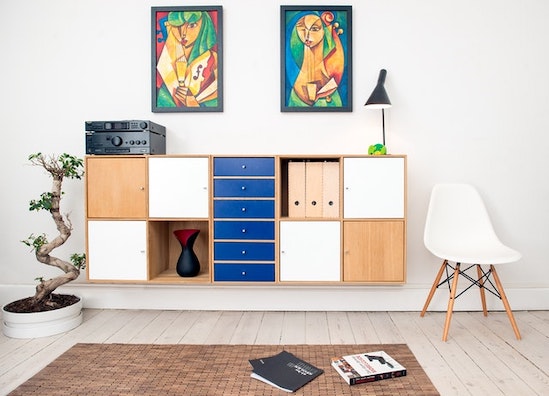Selecting colors for your home design is easy if you know some basic rules. However, it may feel challenging because there are so many shades to choose from, and they need to be put together in the right proportions if you want your home to look classy. Colors must work together in harmony, and they need to look and feel balanced. Read this guide to find out how to use colors in your home design.
Warm vs. cool colors
Colors like red, orange, and yellow are warm and vibrant. There are also warm, neutral colors, such as brown. On the other side of the spectrum are the cool colors, such as blue, green, purple, and gray. Your choice of warm or cool colors can incredibly affect the energy of the rooms. Traditionally, warm colors tend to bring an upbeat and welcoming feel to space. Therefore, they will look best when used in the dining room and kitchen. Cool colors are more subdued, bringing calming energy into an area. They work best in modern bedrooms and office spaces.

Complementary colors
Complementary or opposite colors create the strongest contrast when placed next to each other. Luckily, the complementary color scheme is very simple to use in interior design, since it only involves two shades. If you look at a color wheel, you can pick two shades that are sitting directly opposite each other and choose the combination that you like. The usual combinations are:
- Blue and orange
- Yellow and purple
- Red and green
These color pairings create incredibly high contrast. Even though they bring strong energy into space, you should use them only in small doses. They are often used as accent colors in the interior decoration, with plenty of neutral hues to balance them out. The combinations you choose should look eye-catching but not overpowering.
Look outside for ideas
Bringing the outside in is an inspiration for many color schemes and one of the most popular design trends for 2021. Exterior-inspired color schemes are used so often in interior design because they have a casual and relaxing vibe. You can choose between foliage green, the laid-back blues of the beach, or find your own inspiration outside. This will often include analogous color schemes – colors that are next to each other on the color wheel, such as blue and green. These restful colors work best in informal or private spaces. It’s a good idea to incorporate them into your bedroom, or anywhere where you want to be calm and have some rest.
White can freshen things up
White color modernizes and freshens the space. Painting things white has become extremely popular, especially for furniture. If you have a lot of antique furniture that just doesn’t fit your vision of elegant and modern space, you don’t have to get rid of those fabulous and timeless pieces. Just paint them white, and they will gain a new, contemporary character. For example, white dining chairs look great in elegant dining rooms, making the area look much fresher.

Use artwork and natural elements
Artwork brings color and personality into your home and livens up space, making it unique, so you should choose wisely. Accessories and personal collections can also act as colorful accents in your home, giving it a unique charm. Natural elements like greenery, flowers, and fruits should always be included in home design. They bring lively hues which can refine any space. You can group them in vases or bowls, and you’ll instantly get a more colorful, vibrant room.
Colors can change our sense of space
Colors can even manipulate our sense of space. You can make a small room seem larger if you use light colors. On the other hand, a large room will look smaller with a darker shade on the walls. You can visually lower a ceiling if you use a dark color, or you can raise it with a light one.

Be free to apply your favorite color scheme
Colors are so powerful because they can turn a dull space into a stylish room and unite disparate styles of furnishings. They can also add new life to worn or outdated furniture. Thinking about how to use colors in your home design is exciting because you have the power to transform the space completely, giving it totally new energy.
The majority of people prefer a neutral background, and they choose to add color only with small touches of a selected color scheme. When choosing fabrics and textiles such as rugs, pillows, throws, curtains, and drapes, or bathroom and kitchen accessories, think about inviting colors and be free to add pattern and texture as well. The same applies to furnishing your outdoor patio.
Keep everything flowing
The best way to use colors in your home design is to choose a color scheme for the main room in your home right at the start. Then, you can choose one color from it and carry it throughout your home, but don’t be afraid to add other colors as well when moving from one room to another. This principle will keep your décor flowing. Your home will look cohesive, even though your rooms won’t be too similar to each other.
Remodel your home wisely
When remodeling and decorating your home, you can avoid spending too much money by making smart decisions and staying within budget. Refreshing and renovating doesn’t have to cost a fortune. For example, you can save a significant amount of money if you choose to repaint your kitchen cabinets and countertops instead of buying new ones. You can also repaint your walls, doors, windows, hardwood floors, and almost all your wooden furniture. Choosing the right colors will be crucial. During your home remodeling process, there will undoubtedly be some things that can be done as a DIY project with a few hours of your time, while larger projects may require professional assistance. Whichever plan you make, opt to avoid short-lived trends and instead choose something classic and evergreen.
The bottom line
There’s no absolute right or wrong way to use colors in your home design. Every color can look good as long as it suits your personal style. If you know that something will make you feel happy or relaxed, go for it. Your guest will also love it, as long as it reflects your character.





